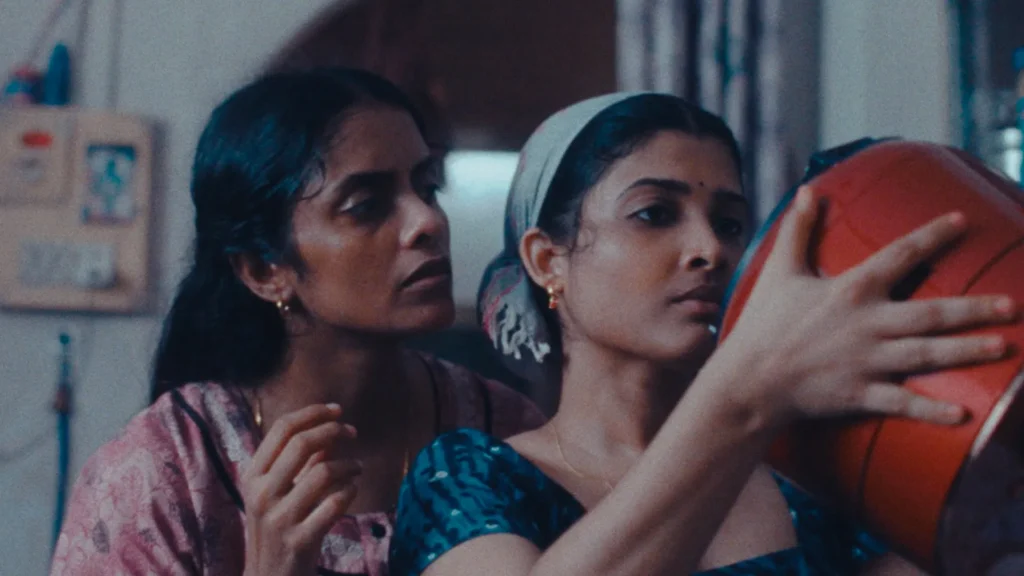
It’s not without a reason Mumbai is called the maximum city. It has space for everyone. Whether it’s sufficient enough to take a clean, deep breath or to sleep without tangling your legs, we are not told. The dubious ‘Spirit of Mumbai’ epithet ensures everyone survives here. In Payal Kapadia’s Grand Prix-winning film Prabhayay Ninachathellam (All We Imagine as Light), three migrant women – two from Kerala and one from coastal Maharashtra glide through the city’s never-ending mysteries.
Kapadia’s protagonist is Prabha (Kani Kusruti), a diligent nurse in a suburban Mumbai hospital. Living with her is a younger co-worker, Anu (Divya Prabha). Prabha is estranged from her Germany-bound husband and Anu is dating a Muslim boy Shiaz (Hridhu Haroon). The couple spends their evening hanging around the city to catch brief moments of intimacy. Prabha’s friend Parvaty (Chhaya Kadam) is a canteen worker at the hospital who fights a local builder to save her modest dwelling that will soon be razed. While Anu and Parvaty get more visible journeys in All We Imagine as Light, Prabha’s coming-of-age is psychological and near-transcendental.
Delving into Prabha’s mindscape, you come across the conservatism bias she operates with and the conditioning she was raised by. Having lived a life of orthodoxy in rural Kerala, the woman shares a common marriage story with countless Malayali women. The elders “fix” her wedding to a stranger who emigrates in no time – leaving her with a long-distance partner she never signed up for. Accepting this situation as her life truth, Prabha wouldn’t peep to breathe beyond society’s sickening boundaries.
Throughout All We Imagine as Light, you observe Prabha as an agreeable woman doing agreeable things. The most liberating thing she does is to throw a rock at a real estate property billboard with the line, ‘Class is a privilege. Reserved for the privileged.’ She leans her head down as a colleague respectfully approaches her with romantic interest. She is unhappy with Anu’s decision to date a Muslim man. It’s just not right – asserts her understanding of life.
Kapadia’s politics isn’t explicit. Skyscrapers bloom like mushrooms, leaving slum-dwellers and alleged encroachers homeless. As Parvaty munches a delicious dinner at a restaurant, she wonders about sheer existentialism. Everything is tagged on a piece of paper. “Can’t you not ask my neighbours if I lived here for over 20 years?”, asks Parvaty to a lawyer. He rejects the idea and cites, “That’s not sufficient in the court of law,” Talk about Kapadia’s masterful allusions.
Through Anu and Shiaz, Kapadia dissects the concept of liberation. Two young people, far away from prying eyes, paint through Mumbai city’s modest haunts despite the rains. Another plan is canceled due to waterlogging in the city. The need for the lovers to get intimate is more urgent in All We Imagine as Light than it ever was in Piya Ka Ghar.

The couple has real problems. There’s a clear lack of funds. Eloping is a bad idea – considering their income and backgrounds. When Anu asks Shiaz whether she features in his plans, the guy gives a realistic answer. You do sense why the woman is with him. For Prabha, intimacy is an abstract concept. She wouldn’t go near Dr. Manoj. “I am married,” she says. The most sexual thing she indulges in is embracing a German-made rice cooker – sent presumably by her husband.
All We Imagine as Light lights up further when Parvaty shifts to her hometown in coastal Maharashtra. It’s a trip that changes the lives of all three women. Prabha’s liberation begins with sipping alcohol from an old bottle. For Anu, it happens with a wish fulfillment. Kapadia’s subtexts are unwavering even when the tempo is slow. As the film ends, the effect is meditative – having lived through Prabha, Anu, and Parvaty’s journeys stitched with hardships, wounds, and uncertainty.
Kani Kusruti enlivens the rigid Prabha as she speaks volumes with her eyes. The woman’s composure is a façade as she longs for company and a meaningful life. You observe Prabha watching a film with a stone face, unlike her colleagues who are immersed in the experience. It is an achingly beautiful performance with the power to make you weep. Anu’s rebellion, again, is never put into words. Watch her nonchalance when she speaks to a woman enquiring about vasectomy. Or her exasperation when the burqa she buys goes to waste. Divya Prabha’s spontaneity is among the film’s greatest strengths. In All We Imagine as Light, Chhaya Kadam is a lot less bold than she was in Laapataa Ladies. Kiran Rao’s film gave Kadam an idealistic prototype. Here, Parvaty is a pawn at the hands of capitalism, politics, and inadequacy. Kadam knows what she is up to and Kapadia even better.
The men of All We Imagine as Light deserve their standalone films. I couldn’t stop smiling when Azees Nedumangadu’s face lit up as he performed a CT scan on a cat. It is as radiant as the DOP’s brightest light when he hands Prabha a bag of delicious Unniappams. Hridhu Haroon’s Shiaz is a radiant man every woman dreams of being with. We wouldn’t know what lies in his and Anu’s future. But when he scribbles something heartfelt on a wall, you would know there’s no need to dispute his love. It is also timely to present a Muslim man in this manner when ‘love jihad’ is all over social media.

It would be stating the obvious to call Mumbai the soul of All We Imagine as Light (I almost did that in the opening paragraph). What I identify in the film as a Malayali man living in the city are Kapadia’s images – of local trains, metro rails, drenched roads, crowded streets, and tarpaulin-covered slum roofs – all of which have grown to become a part of our lives. Migrants are not born into the version of ‘normalcy’ that Mumbaikars live by. One fine day we realized it is okay to be angry if the person walking ahead of you is slow. Mumbai waits for none and you are never prepared enough for it. When Prabha and Anu wonder if they will ever leave Mumbai, it is contemplative for a large ilk that has built their lives on small and big crumbs thrown by the metropolis.
Kapadia’s camera (DOP: Ranabir Das) makes love to Mumbai city. It is at its eloquent best when the handheld motions give us a composite view of the city. Countless close-ups scrape through each muscle on the actors’ faces. The wide and the aerial shots are never employed for grandeur. They are there for us to see the expanses of its people’s emotions. The final shot, staged outside a restaurant, is liberating to the extent that you realize this is the full picture you wished to see. The dialogue between Malayalam, Hindi, and Marathi jumbles smoothly. When Prabha says Hindi is not difficult to master, Dr. Manoj adds how it isn’t for him. They refer to yesterday and tomorrow as ‘kallu’ (which translates to ‘stone’ in Malayalam) – a grudge many Malayalis keep.
In this way, All We Imagine as Light emerges as a stunningly experiential film. We have met these people, gone through their pains, and spoken about such things. In what easily is the most contemplative film-viewing experience this year, Payal Kapadia’s gentle directorial debut bravely steps into the zone of greatness.
Rating: ★★★★ 1/2
All We Imagine as Light was the opening film at the MAMI Mumbai Film Festival 2024 which kicked off on October 18, 2024.


[…] ALSO READ: MAMI Review: – ‘All We Imagine as Light’ is a gentle tribute to compromised lives […]
[…] ALSO READ: MAMI Review: ‘All We Imagine as Light’ is a gentle tribute to compromised lives […]